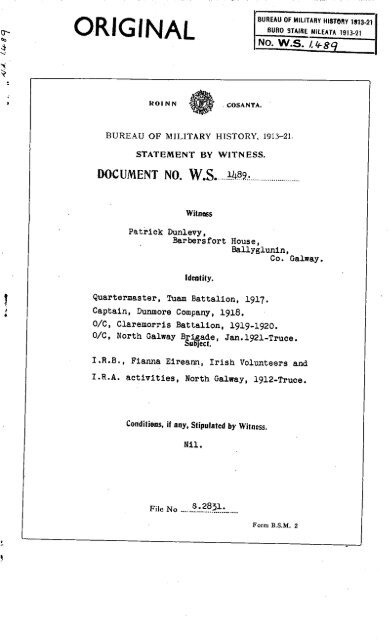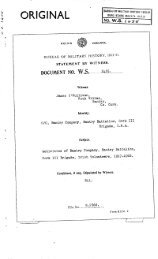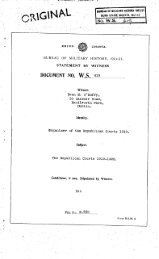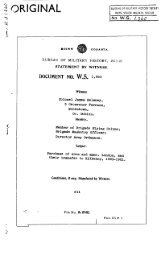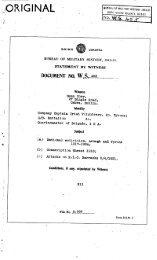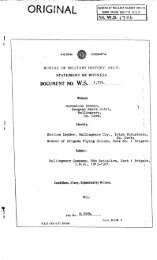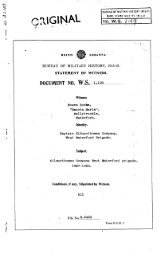ROINN COSANTA. BUREAU OF MILITARY HISTORY, 1913-21 ...
ROINN COSANTA. BUREAU OF MILITARY HISTORY, 1913-21 ...
ROINN COSANTA. BUREAU OF MILITARY HISTORY, 1913-21 ...
Create successful ePaper yourself
Turn your PDF publications into a flip-book with our unique Google optimized e-Paper software.
STATEMENT BY PATRICK DUNLEAVY,Barbersfort House, Ballyglunin, Co. Galway.0/C, North Galway BrigadeI was initiated a member of the Irish RepublicanBrotherhood some time in 1912. There was then a verysmall circle in Tuan. John P. Connolly (deed.) sworeme in. Later, I joined Fianna Eireann under Liam Langley,Tuam.The late Liam Mellows and Archie Heron of Belfastwere constant weak-end visitors to Langley's house andJames Roache's house at Cloontroa Road, Tuam. Aftersome time, we got uniforms and wooden guns, and used totrain under Liam Mellows and Liam Langley at a placecalled Malachy's Plain.Some time in l9l4, there was a Volunteer companyformed in Tuam, and some of the older members of FiannaEireann became officers in that company. They used toparade and drill publicly at Parkmore under ex IrishGuardsman named Shaughnessy, and Philips, and wereknown as Redmond's Volunteers. Later on, there was asplit in the ranks of the Volunteers, and they formedinto two groups, known as Redmond Volunteers andMacNeill. Volunteers. Some of the Redmond Volunteersjoined the British army during the 19l4-l9l8 war.The MacNei1l Volunteers remained faithful to theRepublican cause, but the organisation seemed to fall
-4-some time, the tender returned minus the prisoners, andCummins, Ryan and I were put on to it to meet the samefate, as we thought. After some time at sea, ourhandcuffs were removed, and I thought that they were atleast giving us a chance to swim, but, to our surprise,we found ourselves beside a large vessel of the Englishnavy. We were thrown a rope ladder, and climbed on tothe deck where we again met our companions. Afteragain being searched, we were taken to a storeroom atthe bottom of the ship where we met several otherprisoners, including George Nicholls, solicitor, Galway,Frank Hardiman, Tom Flanagan, Pádraig Ó Mi1le, JohnFaller, Dr. Walshe, Professor Steinberger (Germanlecturer in University College, Galway), Con O'Leary(later Dr. O'Leary), Michel Ó Droinneán, Jack O'Reillyand George Carter. We slept on the floor (metal),with a large gun-cover under and over us. We sleptheads and points, to keep each other warm and to conserveSpace. We subsequently learned that the vessel was acruiser, named H.M.S. Gloucester, and for some days shecruised around the Irish coast.After some days, we were transferred from thiscruiser on to a mine sweeper, named H.M.S. Snowdrop.Our living quarters in this vessel were still morelimited. We were again on the move along the Irishcoast for some days until eventually we arrived at Cobhwhere we were transferred on to a battleship namedH.M.S. Albion. The Albion was stationary at Cobh, asshe seemed to be undergoing repairs. Our livingquarters on the battleship were more spacious, but wewere never allowed on deck. We were at Cobh for aboutthree weeks and were rather enjoying ourselves, as wewere stationary and no one was seasick. Late again
-6-best pal for a time was the late Noel Lemass who waswounded and in Fianna Eireann uniform, R.I.P.During my time in Richmond barracks, I was therewhen Mr. Asquith, then Prime Minister of England, visitedthe barracks and went to several rooms and talked toand questioned prisoners. His usual questions were,"What is your name?" "Where are you from?" and "Whywere you arrested?" After his visit, we were givenbetter food and more blankets. I was subsequentlyreleased from Richmond barracks.In 1917 a battalion was organised in Tuam.John P. Connolly (deed.) was appointed 0/C. John J.Waldron, Central Stores, Tuam, was adjutant, and I wasappointed quartermaster. All County Galway was thenone brigade under Seamus Murphy, with Mattie Niland ofGalway as adjutant, and the late Sean Broderick,quartermaster.Later in 1917, I went to work in Dunmore, and hadto resign my appointment as quartermaster, Tuam battalion.There was then a very strong circle of the I.R.B.in Dunmore. The late Thomas Kilgarriff was centre. Hesubsequently became centre for North Galway.After some time in Dunmore, we formed a Volunteercompany of which I became captain. The late MichaelRonayne was quartermaster, and Willie McGill, adjutant.Ronayne and McGill were internees from Frongoch.There was very little Volunteer activity during 1917excepting drillings, training in engineering, etc.In 1918, the I.R.B. and Volunteers took an activepart, with Sinn Féin Club, in the election campaign, and
-7-organised a house-to-house canvas in the whole area forDr. Brian Cusack who was the Sum Féin candidate and whowas elected M.P. for North Galway. Dr. Cusack was thenin gaol and was a native of Co. Clare. The Volunteersalso enforced the boycott of Belfast goods, and laterassisted in establishing and enforcing decisions of SinnFéin arbitration court5.I was appointed to take charge of Volunteers inNorth Galway by Brigadier Seamus Murphy during electionsin 1918, with headquarters at Tuam. A party ofVolunteers were on duty at each polling station, and thisparty escorted the ballot boxes to receiving centre atTuam courthouse where a specially selected party ofVolunteers remained on duty with R.I.C. all night, toensure that nothing happened to ballot boxes until thecounting of votes next day. These activities naturallybrought some of our officers and men into disreputewith the R.I.C.In 1919, I went to work in Claremorris and, aftersome time in Claremorris, I was appointed 0/C of thatbattalion. I still kept contact with my old fellowI.R.B. men and Volunteers in North Galway, and I usedto visit the area very often, as things were much moreactive at that time in the Tuam area. Sometime in1919 or early in 1920, there was a meeting of ConnaughtI.R.B. men held at Gray's Hotel, Tuam, and I waselected secretary for Connaught. The late LarryLardner of Athenry arranged this meeting. During theearly part of 1919, I travelled by bicycle on severalSundays with Larry Lardner to various circles in Galwayand Mayo, inspecbing and organising I.R.B. circles.
-8-At Easter 1920, I took part with Seamus Maloney,the late Dr. Paddy Mullins and Sean Lohan (killed duringthe Civil War) in the destruction of Income Tax papersat Kirwan's, Dalgan House, Miltown, Tuam as I happenedto be home for Easter on holidays and met the Tuambattalion officers at Tuam on Easter Saturday night.The Tuam battalion also burned evacuated Barnaderg R.I.C.barracks, Castlegrove and Castlehackett, and anevacuated police hut at Abbeyknockmoy on the same night.I had made arrangements for the destruction ofincome tax papers at Claremorris on the same night, beforeI left cycling for Tuam. This operation was not carriedout in my absence at Claremorris, and, after returningto Claremorris after the Easter holidays, I had to carryout this job at great personal risk, as the excise officewas only a few doors away from the R.I.C. barracks.After holding up the excise officer Mr. John Donoghue,by arrangement and getting keys, we had to have acovering party beside the R.I.C. barracks during theoperation.In July 1920, a party of six R.I.C. fromClaremorris went to Westport for duty at Croagh Patrick(Reek Sunday). The late Harry Burke, battalion adjutant,Claremorris, Fr. Tom Burke and myself went to Wesportand succeeded in finding out that this party of R.I.C.were again returning to Claremorris the same night. Wedecided to ambush this party on their return journeybetween Claremorris and Balla. This party of R.I.C.returned by a different route and we missed them.Early in the month of August 1920, I arrangedwith Tom Maguire of Cross, Cong (later O/C, 2nd WesternDivision), to enter Cross R.I.C. barracks in British
-9-military uniforms for the puposeof capturing thebarracks and equipment.Harry. Burke (deceased), Willie Kenny, now livingat Kiltimagh, Co. Mayo, Willie Hearey, Claremorris, andmyself went to Cross on a Sunday morning, dressedinBritish military uniforms, and we met Michael O'Brien,adjutant, South Mayo brigade, and later killed atTourmakeady. O'Brien told us of the arrangements forthe operation, and O'Brien then went home across thefields. Our instructions were to pull up the caroutside the barracks, and to try and enter samethat there would be a party of men on the opposite side ofthe road to rush the barracks as soon as the, door wasopened.We waited for some time outside the barracks, andeventually Kenny (who was driving the car) and I got outof the car and went to the barrack door for water forthe radiator and all this time, there was no move fromthe men on the oppositeof the road. Then, assidethe congregation were coming from Mass in the churchnearby, Burke, who was in officer's uniform, told us wemust move off, which we did. There was also anarrangement for men to meet us in a wood between Crossand Shrule, to take over our uniforms and capturedequipment, but there were no men there, and we had todrive through Shrule,to a place called Sylane,Headford,near. Tuam, before we could divest ourselves of militaryuniforms and get into our own clothes. I subsequentlylearned that all arrangements miscarried, and that therewere no Volunteers at either the wood or road near theR.I.C. barracks. Tom Maguire himself was at Mass inthe church nearby during this operation.
-10-Shortly after this, R.I.C. and Black and Tans,masked, raided for me at Begley's of Claremorris whereI worked as manager of a branch house. Fortunatelyfor me, I was not in bed when this raid took place.Previous to this, I had received a "death" notice whichI still hold. I then went on the run, and remained inMayo area for some time but, as it was impossible toorganise any operation of a military nature, I reported toG.H.Q. and to the I.R.B. in Dublin.After consultation with the late Sean Ó Murthuile,I.R.B., the Adjutant General, the late Gearoid O'Sullivan,the D.I., the late General Collins, and the Director orOrganisation I think it was Diarmuid O'Hegarty I wasinstructed to return to Tuam area and reorganise thebrigade, which I did, and on the arrest of Brigade 0/CCon Fogarty, I was appointed 0/C of the brigade inDecember 1920 or early January 19<strong>21</strong>. I had thenestablished contact with G.H.Q., and I was instructedto get rid of any officers who were inactive and toorganise battalions and companies.I was also instructed by G.H.Q. to enquire aboutsix rifles, six revolvers, twenty-four hand grenades,three hundred rounds of .303, and three hundred rounds of.45 revolver ammunition that had been consigned to afictitious name in Headford as a box of hardware for thelate Commandant Louis Darcy. I found that thisprecious box was still lying at Tuam station from theMay previous, and I took possession of same, asinstructed by G.H.Q.In the Tuam brigade area., particularly in No. 1(Tuam) batta1ion the organisation had deteriorated
-11-very much after Battalion Commandant Michael Moran waskilled by the enemy. There was a lot of desertions bybattalion and company officers, and there was only oneofficer my late brother, Tom, who was then quartermaster.quartermaster. The same applied to the brigade staff, asthere was only Patrick Conway, brigade quartermaster.After my appointment by G.H.Q. as brigadecommandant, I appointed Thomas Tormey, now in the U.S.A.,as brigade adjutant, Patrick Conway as brigadequartermaster, Tom Kilgarriff (deceased) as brigadeintelligence officer, M.J. Ryan as brigade engineer,and Tom Concannon as brigade chief of police.I appointed Thomas Dunleavy (deceased) as 0/C,Tuam battalion, Peter McHugh (deceased) as Vice 0/C,Thomas Ryan as battalion quartermaster, James Burke asintelligence officer, Stephen Keane (deceased) asbattalion police officer, and Sean O'Neill as adjutant.(I subsequently found O'Neill unsatisfactory andappointed Thomas Nohilly as adjutant in March 19<strong>21</strong>.)See attached appendix for Glenamaddy battalion andcompany officer, and also for officer of companies ofthe Tuam battalion.I formed a flying column early in January 19<strong>21</strong>.This column was mostly made up of officers and men whowere on the run and were staying in hiding indifferentplaces throughout the area in both Tuam and Glenamaddybattalions.Our first job was to locate rifles and ammunitionthat had been concealed in dumps by men who had desertedand gone to England. Most of this ammunition wasafterwards found to be bad.
-12-After locating the concealed rifles and ammunitionplus rifles taken from Tuam station, our first attemptat an ambush was at a place called Gortaleam on theDunmore-Williamstown road. I had arranged with allbattalion and company officers for detailed weeklyreports of enemy movements in their respective areas,and we found that police from Dunmore usually travelledto Ballymore via Williamstown between the third andfifth day of each month. As this whole area is veryflat, we had decided that this was the best positionfor an ambush, as the national school was near thisposition. We had to place a guard on the school inorder that our presence would not become known.We occupied positions on both sides of the. roadat dawn. As no enemy came along before 5 p.m., we hadto call off the guard from the school and withdraw, asthe parents would become uneasy when their childrenhad not returned home. We afterwards occupieddifferent positions on this road away from the school.We occupied positions on the Ruan-Dunmore road.We had found, from reports, that three lorries usuallytravelled on Saturday or Wednesday along this road.We had to evacuate two families to occupy this position,Flaherty's and Piggott's but had to withdraw after oneday.We occupied a position at Dalgan, Miltown, on themain Dunmore-Miltown road, but had to evacuate thisposition early in the day as we had to hold up too manypeople who were on their way to Mass. Shortly afterwithdrawing from this position, three lorries of R.I.C.and Tans passed, going to Miltown from Dunmore, and wewere regretting evacuation and missing ambush. Three
-13-large lorries of British military came from Irishtownto Milltown along a bye road which was linked up withthe position we had just left. Had we remained inour original position, these lorries would have come upon our rear, as there is a network of roads in thislocality.We attempted an ambush at Laught (Moylough) aswe had information that a party of R.I.C. and Tans usedcome from Mountbellew to this public house, usually on aSunday. After remaining there all day, nothinghappened. We occupied this position twice.We occupied a position at Knockroe, Abbeyknockmoy,to intercept a patrol of R.I.C. and Tans that used comefrom Monivea to Abbeyknockmoy. We stayed in thisposition for a whole week, and had to leave same as toomany people knew of, our presence. There was only asmall section of the flying column in this position.We occupied an ambush position at Lisavalleybetween Derreen and Barnaderg, but again without result.We occupied again a position on the TuamDunmore road. The whole A.S.U. was there, reinforcedwith local companies of Dunmore, Cortoon and Clonberneagain without result.We occupied a position at Kenmoy Ballyglunin.I had first arranged for destruction of Belfast goodsat Ballyglunin station and had asked the stationmaster,a Mr. Hogan (deceased), who was friendly to report sameto R.I.C. at Turloughmore, so that they might come toinvestigate. Unfortunately, the consignee, a Mr.Costelloe, came to the station to deliver goodspotatoes from Belfast which we had dumped into nearbyriver. Costello returned to Tuam, and reported to
-l4-the R.I.C. and military who later came along in fivelorries and rounded up civilians from togs and housesto collect the potatoes from the river. Whilst allthis was happening, we were lying in ambush for theTurloughmore police in a wood beside the railwaystation. A patrol of eight R.I.C. did come fromTurloughmore, but I had to withhold fire, as there wereabout a hundred R.I.C. men, Tans and military justoutside the demesne wall. When it came to evening, thelorries returned to Tuam. The patrol from Turloughmorereturned home by an alternative route, and we missedgetting them. I might add that, only for the efficiencyof our outposts and scouts, we would have been surroundedon this occasion as, if we had attacked the patrol fromTurloughmore, our position would have been hopeless.We again occupied a position on the Tuam-Dunmoreroad at a place called Sylane, and, in the early hoursof the morning, I got a despatch to proceed immediatelyto Quigley's house at Croswell in County Roscommon toarrange an operation at Dunamon railway station with anofficer from G.H.Q. His name was McMahon, I think.I was also instructed to detail the best rifle andrevolver men. in the brigade area to proceed to GalwayRoscommon border and await instructions there. Therewas also a despatch to be delivered to the 0/C of theSouth Mayo brigade (Tom Maguire).I sent on this despatch to Mayo, and withdrewthe men from the position near the road. I broughtthem to a village called 0arrarea, Brownsgrove, andplaced Brigade Adjutant Thomas Tormey and QuartermasterPatrick Conway in charge. The position was threehundred yards from the road. I allowed the shotgun
-15-men to return home. I left instructions for theriflemen to snipe any lorries or enemy that might passalong the road and move towards Ballymoe that night,which they did. Three lorries of R.I.C. and Tans fromTuam came along, and were sniped. Whilst sniping wasin progress, four lorries of R.I.C. and Tans came inthe opposite direction from Dunmore. They dismounted,got in across fields and nearly had our unit surrounded,when they retired towards Lavally after exchange of fireand dusk came on. District Inspector O'Callaghan fromTuam was wounded in this operation.Battalion Commandant James Maloney and 1 went toRoscommon and met the officer from G.H.Q. who wasspecially sent by Director of Intelligence, GeneralMichael Collins, to arrange to intercept a convoy ofrifles, ammunition and other equipment that was beingsent from Athlone to Claremorris. The plan was toattack the convoy at Dunamon railway station. This wason a Saturday, and the convoy was to pass on thefollowingMonday.Although we were actually in the brigadeadjutant's house Quigley's, as far as I can rememberand the despatch had been addressed early on Saturday toSouth Mayo, neither the South Roscommon nor the SouthMayo units turned up, and the officer from G.H.Q. calledoff this operation on Monday morning. Maloney and Iasked him to attempt the operation with our brigadeA.S..U., but he refused. I hope that this officer fromG.H.Q. (Sean McMahon) is still alive and can verify.It was not Sean McMahoh who was then Q.M.G. We placedscouts at the railway station, and we found that theconvoy did pass on Monday only one N.C.O. and seventeensoldiers.
-16-We again lay in ambush at a place called Kilnalagg,Polredmond, on the Dunmore-Williamstown road, andoccupied this position for two nights and three days.During this occupation, an aeroplane came over us,flying very low, but I assumed that it was only scoutingthe road for some important enemy officer who might becoming along. Otherwise, we could easily have broughtit down. Unfortunately, I was wrong in my assumption(which I will always regret).Again we had to evacuate this position as toomany people knew of our presence. Before we left thisposition, on the third evening, we got all the localpeople to cut and block these roads, and I told them toget away if they heard any shooting as I put a sectionon either side of them for their protection.We moved on from there to a place called Park,near Clonberne, which was then the only road left openfrom Dunmore to Glenamaddy and Williamstown, bit againwithoutresult.There was agrarian trouble at a place calledForth Brown, and R.I.C. and Black and Tans had beaten uptenants, in a village named Ballinahown, who were causingtrouble to a man named John Henry Burke, now residing inCo. Meath. I thought that It would be an ideal wayto get the enemy to come out. So I arranged a goodcattle drive off his lain, and instructed the Volunteersfrom the local company, Cortoon and Cloonberne, to driveBurke's cattle and sheep on towards Moylough, and toreturn home when they had done so. This was done, andwe lay in ambush at Freaney's Cross, Clonberne. We hada very good position here, on both side of the road.
-17-I had trees cut almost through, and bound witha rope each to another tree, so that a Volunteer wouldonly have to cut the rope when the enemy had passedthrough on either side, and the trees would fallimmediately and hem them in, but again no enemy came along.This position was afterwards described by the enemy as a'veritable death trap."During this operation, an ex British army officernamed O'Rourke came along with his daughter and twoservants on horseback. They rode into the position ofsome of our outposts and were held up. I offered to letthis man go home if he pledged me his word of honour thathe would not divulge our presence to the enemy, but hedefinitely said, "No", and said that he had told hiswife, when leaving home, that he would be back fordinner. He also told me that, when he would not beback for dinner, his wife would go to Tuam and report hisabsence to the British authorities and that they wouodbe out to investigate. I told him that this was the bestnews that I had heard for a long time, that there was onlyone authority, that we would let his friends know who thatwas when they came to look for him, and that we would haveto hold him in order to bring them out. I admired thisman's bravery, and think it fair that it should go onrecord.One of his servants, Harmon, who had been alreadysentenced to death for espionage and who had got severalchances to leave the district, was with O'Rourke.Unfortunately, Hannon had seen some of the me who were hisneighbours, viz., Thomas Wilson, Michael Gannon, ThomasRyan (deceased), Michael Cleary and some others who werenot on the run at the time but who were reinforcing the
-18-column for this operation. Otherwise, the brigadecouncil might have given Hannon another chance to leavethe country rather than carry out the death penalty.I told Harmon to make his peace with God, and took himaway from the prisoners. I also told him that, if wehad the opportunity, I would let him see a priest, whichwe did later that evening, and duly carried out theexecution, and labelled the spy, 'Convicted Spy.Executed by I.R.A. Others Beware!"At this stage, the enemy were not moving out,except in large humbers, usually four to six lorries, inTuam brigade area, as they had learned of all theseprepared ambushes and were more than cautious. Ireported this matter to G.H.Q. as I was in Dublin fouror five times for conferences and asking or begging forsome equipment, as the brigade quartermaster had handedover the rifles, revolvers, grenades and ammunitiontaken from Tuam railway station to Commandant LouisDarcy to be used in his area. I did not quite approveof this action by Quartermaster Conway, but it was donein my absence. I don't think that these rifles wereever used, as poor Louis Darcy was killed at Oranmorestation, and afterwards there was a lot of equipment inthis area surrendered to the enemy and piled up atKilroe castle because of threats by Black and Tans toburn all the houses in the area if arms were notsurrendered within a certain date.I had got permission from G.H.Q. shortly beforethe Truce to operate outside the Tuam brigade area as Ihad pointed out that all our good and best positions wereknown to the enemy and they were either moving in toostrong a force or not coming out at all.
-19-The flying column were moved into Moylough area,as we had information that a party of Protestant Blackand Tans used to come from Mountbellew to church inMoylough eon Sundays. Usually four or five CatholicR.I.C. men came with them and did guard outside thechurch during service.We billeted on a Friday night in a village calledShankhill in Mountbellew area, and moved into positionbetween Mountbellew and Moylough at daybreak on Sundaymorning. We had to occupy two houses and outhousenear the road, as our position was very exposed to viewof people going to Mass. I placed a scout up in aholly bush on a hedge near the road. He had a clearview of the road leading from Mountbellew and could notbe seen himself. I arranged a signal with him when hesaw the enemy approaching as we could not occupy theposition beside the roadway without being observed.This scout, the late Captain Patrick McHugh,mistook a cloud of dust in the distance for a militarylorry, and gave signal of approach. The A.S.U. rushedinto position, only to find his mistake, and we had togo back again into the cover of the houses. In doingso, we met several people going to Mass and we had todetain them for safety as they were all strangers to theA.S.U.Whilst this was happening, the enemy came alongon bicycles twelve in all and cycling two deep,about two hundred yards between each file, and as therewere only sixteen of us, it was impossible to hit them.We changed our position then, in order to deal with themon their return, but they returned by an alternativeroute via Laught and Springlawn.
-20-We then moved on to the opposite side of the road,and remained in a position about one hundred and fiftyyards from the main road. There was a high ridge behindthis position, and fortunately I took the precaution ofcutting holes through sod fences in case of having anengagement and having to retreat. This precaution wasinstrumental in saving us from casualties later on.At about 7 p.m., one R.I.C. man and a little girlcame along, cycling from Mountbellew to Moylough, and welet them pass on. Later, another R.I.C. man, namedNeilan, passed, cyling from Mountbellew to Moylough. Isent four men from the column, viz., Captain PatrickTreacy, Captain Brian Conniffe, Captain Tim Feerick(deceased) and Battalion Quartermaster John Knight, intoMoylough, armed with revolvers and a few bombs, and toldthem to shoot these two police and return by adifferent route, and to man their positions again, armedwith rifles, for an engagement.I expected that Mountbellew barracks would benotified immediately, as there were no wires or roadscut in the area. These men carried out my instructions,but only succeeded in wounding Neilan as he got awaythrough a hedge. The other man escaped from a publichouse, although Conniffe and Knight fired seversl shotsat him. These four men moved off in the Tuam directionand then returned, by a circuitous route, to the mainbody as instructed. They were just back in positionwhen two lorries, and a private car of R.I.C. and Tanscame from Mountbellew to Moylough. They weretravelling a good distance apart, and I decided to letthem pass, on account of the distance between eachvehicle, and rise on the ground at the Moylough side ofourposition.
-<strong>21</strong>-After enemy had spent a good while in Moyloughand had searched the country in the Tuam direction, theywere returning to Mountbellew and travelling pretty close,when we opened fire on them. The leading driver wasput out of action and the lorry pulled up, as did theprivate car and the next lorry, and they succeeded ingetting cover in a drain on the opposite side of theroad. The fighting lasted for about one and a half hours.We had a lot of defective ammunition, and I got fivemagazines of ammunitioninwhich there were only a fewgood rounds. This was ammmnition that had been buried ina bog hole in 1920. I met a man, named Thomas Higgins,from Moylough who gave us some good ammunition that wasin the Mountbellew battalion; otherwise we would neverhave got away from this position as we could not try aflanking movement. If we could have flanked the enemyfrom an elevation on the Moylough side, I have no doubtthat we would have made a complete success of thisoperation. We had to wait on until dusk to get away,and then only in sections. We had to conserve ourammunition, and had only five rounds for each rifle leftafter the operation.I do not know what the enemy casualties were, butI do know that there were at least five killed or wounded,as I subsequently met a man named Christopher O'Connorwho was commandeered to drive the private car for theR.I.C. that evening, and he told me that, in addition toone wounded man in the car from Moylough, there were fourother casualties, as far as he could see, but that thepolice hid them away from him.During the months of May, June and July beforethe Truce in 19<strong>21</strong>, the enemy rarely moved out by day,
-22-and then only in great strength. All their movementswere mostly by night, and then often in cycle patrolswhich were always a great danger to the flying column.We now decided to go into the towns occupied bythe enemy in the brigade area Tuam, which was occupiedby about sixty Tans and R.I.C. and a company of militarystationed in the courthouse and workhouse, beside thetown, Milltown, occupied by about forty-eight Tans andR.I.C., Dunmore occupied by about sixty Tans and R.I.C.,and Ballymore, by between thirty and forty Tans andR.I.C.By this time, I had the column divided up intothree sections one section to cover Tuam and Dunmore,one section to cover Miltown, and one section to coverBallymoe. It was next to impossible to get into Tuamas the company there was not very active, and the bestof our men were either arrested or on the run.However, we did get into Tuam on two occasions,via Bishop Street and Shop Street, but all was quiet.I found from reports from our scouts after these entriesthat some undesirables must have seen us and conveyedthe information to the enemy, as military, Tans andR.I.C. used to lie in ambush at night on the approachesto Tuam, and we had to abandon this plan for Tuam.I was in charge of a section that went into thetown of Dunmore on several occasions five nights insuccession one week. We used to go in at night andremain in position until daybreak, and then withdraw toa house owned by. Michael Donnellan's mother. (Donnellanis now Parliamentary Secretary to the Minister forFinance.) We also learned that our movement here werediscovered, and we had to give up the plan for a while.
-23-It was one of these xnovement5 into the enemypositions that led to an ambush at Miltown in June 19<strong>21</strong>,in which an R.I.C. sergeant and a Tan, were killed andthree Tans wounded. My late brother, Torn Dunleavy, wasin charge of this party. Vice Commandant Martin Ryanwas in charge of the party that used to enter Ballymoe,but without result.We had practically no ammunition left when theTruce was declared. I would say we had only aboutfive rounds for each rifle, and a few rounds for eachrevolver.The Whole-time members of the flying column, asfar as I remember, were:-Patrick Dunleavy John Knight.Thomas Dunleavy Peter Brennan.Tim Dunleavy Thomas Feerick.Tom Tarmey Peter Burke.Patrick Conway Patrick WalsheJn. J. Ryan John P. McCormackTom Kilgarriff Dan McCormackThomas Mannion Martin flatteryMartin Mannion Thomas NohillyJames Maloney Thomas RyanMartin Ryan Willie FeeneyPatrick Treacy Patrick McHughBrianConiffeIn addition to these military activities, theTuam brigade had to carry out several other duties, suchas enforcing of boycott on Belfast goods and enforcingthe decisions of the Republican courts as long as thecourts were functioning. These courts ceased to
-24-function early in 19<strong>21</strong> as judges were either arrested orhad to go on the run. Con Kennedy (deceased), MichaelFinnegan (deceased), Tom Kilgarriff (deceased), Mrs. E.Costello, Willie Dooly and Gabriel Guy (deceased) weremembers of the.epub1ican courts. Gabriel Guy waslater district justice in Ballina.When these courts ceased to function, the brigadecouncil took over administration, and amicably settledseveral disputes in order to prevent litigants going intothe British courts.The brigade conncil had also to arrange for financefor the general election in 19<strong>21</strong>, as all the politicalofficers of Sinn Féin Comhairle Ceanntar were left thearea, and money had to be found to lodge deposits fornomination of candidate. As far as I can remember,North Galway's share in financing deposits was £450, andwe borrowed this amount from the late Dean (Canon)Macken of Dunmore.We had to collect all this money throughout thearea, and made a levy on each house, according tomeans. This amount was paid back to Dean Macken.There was a snap dissolution of the BritishParliament some time during hostilities in 19<strong>21</strong>, and theSinn F8in candidates were returned unopposed.There seemed to be more enemy activity in Tuamarea than in the adjoining areas in Co. Galway, cudthe enemy burned my father's house and some other houses,including the home of the late Jeremiah Mee.We burned the workhouse at Glenamaddy as we hadinformation that it was about to be occupied by
-25-themilitary.There were several large scale rounds-up inthe area, including the surrounding of the whole ofGlenamaddy, Williamstown and Ballymoe area by hundredsof Auxies, R.I.C., Tans and military from Claremorris,Galway, Boyle and Athlone, but luckily no member ofthe flying column was caught in the net.SIGNED:PatrickO'SeynnpléfréDATE:September5th1956WITNESSSeán Brennan Lieut Col.
APPENDIXTuam Battalion ten Companies:BarnadergTimDunleavy.TuamPat Geoghegan (deserted);subsequently Patrick Colleran.SylaneCorofinGardenfieldPatrickWillieMartinMcHugh.Feeney.Higgins.MiltownTorn Feerick(deceased).BelmontThomasHannon.AbbeyknockmoyJohn Fleming (deceased).KilconlyCortoonFrankThomasCunningham.Wilson.Glenamaddy Battalion ten Companies:BattalionBattalionBattalionBattalionBattalion0/C James Mahoney.Vice 0/C Martin Ryan.Quartermaster John Knight.Adjutant Martin Mannion.Intelligence Officer M.J. Walshe (deceased).DunmoreKilternaThomasRoddyMannion.Rabbit.PolredmondJohnGlennon.WilliamstownPaddy Noonan (deceased).KilcroanJohnHanley.GlynnTorn Burke.KilbegnettKilkerrinGlenainaddyClonberneJohnBrianPatJohnMcDonagh.Conniffe.Treacy.Mahon.


